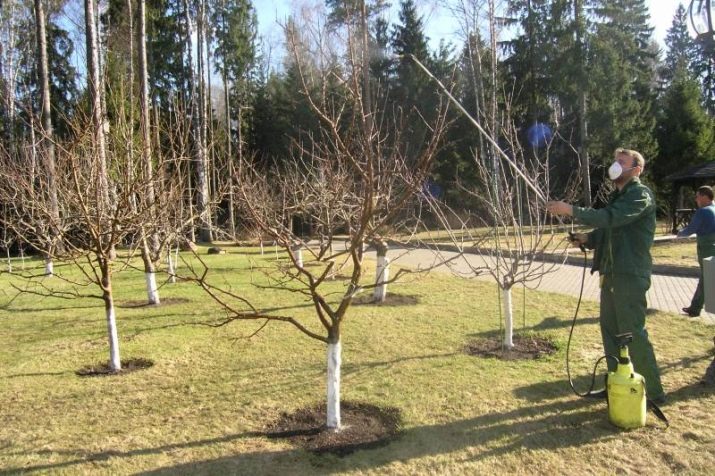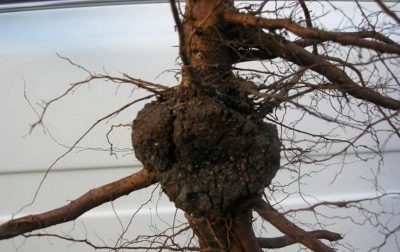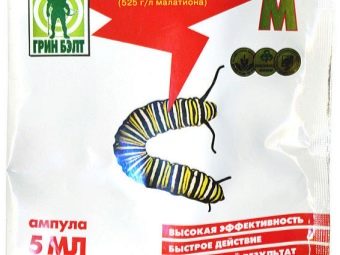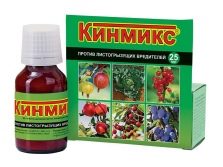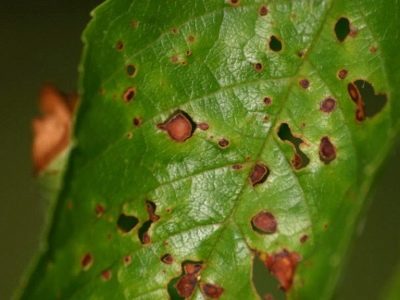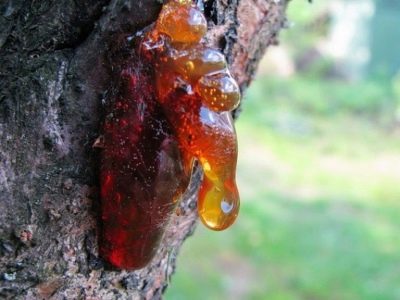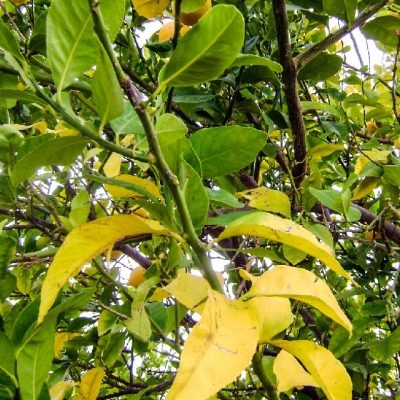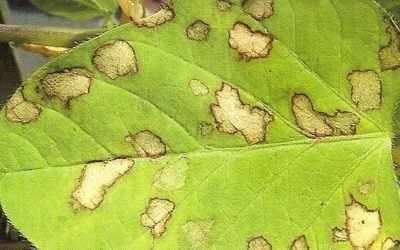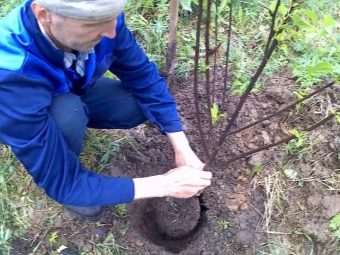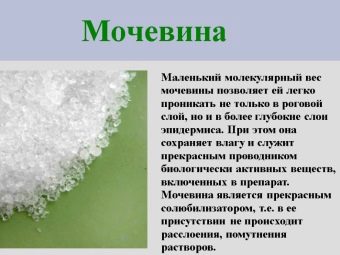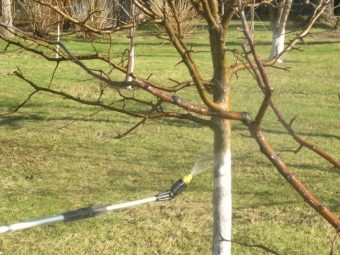Sweet cherry diseases: description and treatment methods
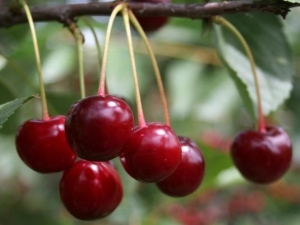
Growing a healthy fruit tree is not an easy task, especially when it comes to sweet cherries.Due to the early ripening period, the pests rarely affect the crop, but if we neglect the therapeutic measures, all the diseases will be introduced very deeply and after a season the tree will die.
Symptom Description
Humanity began to grow cherries more than two thousand years ago. Malaysia is considered the birthplace of this fragrant and juicy berry, where it was noticed by one of the Roman commanders Lukull. It was he who brought this culture to Europe, from where it came to our country.
Over time, the cherry has adapted to new conditions, but under any unfavorable conditions it becomes the object of attack by pests, fungal and viral microorganisms.
By nature, all the pathologies of the cherry tree are divided into the following types.
- Fungal, which lead to all sorts of spotting, death of leaves, stems and fruits. This type of disease is one of the most common. Fungi multiply by spores, which are easily transferred from tree to tree by wind and rain.
- Bacterial are the result of germs, dirty tools and pests.
- Viral - spread by insects, quickly transferred from one plant to another. Unfortunately, today there is no cure for viral infections of horticultural crops, as they damage the vascular system of the plant. Save the garden can only destroy the diseased seedling.
- Non-infectious - this problem arises as a result of illiterate care, improperly performed pruning, breaking of branches, increased fruit or snow load, as well as sealing the cut point with wax.
Infection with infections most often occurs in early spring when, with the arrival of heat, various pests awake and become active. It is at this time should be the most meticulously inspect the entire plant for the detection of damaged branches - in this case, the problem area should be removed, and the insects and larvae shake.
At the same time, medical and prophylactic treatment of the plant with chemicals can be carried out. After the stage of formation of the fruit ovary begins, the use of insecticides is no longer possible, and the cherries do not cure the disease with folk remedies.
If the cherry tree starts to wither and dry, then this may be a signal that the plant starts moniliosis or a bark beetle defeats the garden beetle.
If the spring and summer begins massive yellowing of the leaves, their twisting and falling off, then most often it says fungal infection (coccomycosis) or the presence of ant colonies around the tree. Keep in mind that by themselves, these insects can not harm the tree, but they are peddlers of aphids, which eat the leaves and young branches of the plant, reducing the supply of its vitality and causing the fruits to dry. In addition, the reason for the withering of the foliage may be a lack of nitrogen, in this case, try to feed your "pet."
If the fruits soon after formation begin to fall off with the external integrity of the plant - the likelihood of root parasites is high. More rarely, but the reason may be a lack of minerals in the soil and a shortage of water.
If the sweet cherry does not form fruits, then in most cases this is a signal of the acidification of the soil, but also a similar problem manifests itself in root cancer. This is a viral disease that cannot be cured - the plant must be destroyed.
Varieties of parasites
One of the most common garden pests that can cause significant harm to the culture is sawflies.
Mucus sawfly leaves eggs on the surface of leaf plates. Brown tubercles visible to the naked eye. Going deep, they eat the leaves. Yellow plum - this type of insect eats berries, while it leaves its excrement in them, as a result, the cherry becomes an unpleasant odor and becomes unfit for consumption.
The sawman can be removed with the preparations "Pyriton" and "Iskra-M".
Cherry trumpet ruins leaves of sweet cherry and her relatives - cherries. As a result of its parasitic impact, they begin to curl into a dense tube and as a result begin to fall. It is inside the tubule that the tubovert places its eggs, from which the larvae hatch. They feed on the leaves and almost immediately destroy all the green parts of the sweet cherry. From this pest use "Benzo -" and "Carbophosphate".
The cherry weevil strikes the fruit — insects lay eggs in their pulp, and a small dark dot forms on the skin of the fruit. It is the entry point of insects, which is smeared with their secretions. As hatching, the larvae move into the bone, eat out its core and completely destroy it. Adults also do not squeamish buds, buds and foliage plants.
To combat sawfly, Rovikurt, Karbofos and Inta-Vir have proven themselves well.
In the last decade of September and early October, trees fall victim to the attack of the winter moth - this insect holds together individual leaves with thin cobwebs and lays eggs. The larvae hatching out eats away the flesh of the leaves, leaving only strong streaks.
You can help the plant by spraying it with chlorophos; moreover, in the early stages of the lesion, the insecticide “Call” and “Zolon” have proven themselves well.
Black aphids quite often attack cherry trees. Its larvae suck up the vital juices from the green parts of the plant, and literally in 3-4 weeks the leaves curl and dry, and the young buds die without disbanding. To get rid of an unpleasant insect, you can use the tool "Aktelik" or "Intra-Vir."
Many experienced gardeners recommend the use of tobacco dust or fermented leaves of a simple dandelion.
The invasion of the fruit moth can in a few days completely lime all the leaves of the plant. These small caterpillars leave behind only bare branches. Get rid of them is quite difficult. If you treat the plant immediately after the pest is detected with Iskra or Kinmiks, you can try to save the plant.
A lot of trouble can be caused by the cherry fly, which infects the berries of the sweet cherry. As a result, the fruits darken, get a matte shade, and their flesh begins to ooze even with the weakest pressure. At the same time, cavities form on the surface of the berries, and the skin begins to burst.
To overcome the enemy helps the solution of fungicides "Lightning" or "Spark".
Diseases
Let us dwell on the most common diseases of the cherry trees.
- The nature of such pathologies can be either infectious (with fungal and bacterial lesions) or non-infectious (which is the result of cracking, lightning strikes, temperature drops, etc.). Against this background, most often occur any kind of spot. Brown spot It appears as brown spots of rounded shape with dark edging. As the disease spreads in the affected tissues, darkened dotted fruiting bodies form. As a result, the necrotic tissue begins to crack and fall out, and small holes appear on the cortex. If the sweet cherry is not treated, then after a short time the bark will completely sink, and the leaves will turn yellow and fall off, while the spores of the fungi remain in the fallen leaves.
- Cercosporosis - fungal infection, which manifests itself in the summer in the form of numerous small round spots, their color is red, the edging is purple. At the same time, sporulation is formed on the lower part of the spots, which looks like dark pads. As the disease progresses, the affected tissues fall out and holes remain on the cortex.
- Jaundice - This is a mycoplasmal infection, which is manifested in the fact that young leaves begin to brighten, we hide the spots quickly rise and as a result, patches of pale yellow color are formed. Lack of treatment leads to deformation of the leaves and the formation of tasteless small fruits.
- Septoria cherries affect mainly the petioles, which leads to drying of the fruit. They become deformed, lose their taste and product quality.
- Witch's broom - Another fungal disease, which is manifested in the fact that on the branches of sweet cherries grow in a large number of thin densely located shoots, which are purely visually resemble a broom. They grow small leaves with a yellowish tinge, and on the bottom you can find a grayish bloom - this is where spores nest. The fungus affects the fruit, causes a change in their shape and loss of taste.
- Stem rot leads to decay of wood, as a result of which trees can easily break. Most often, the infection starts from the root collar and quickly spreads upward.
- Monilial burn - A typical sweet cherry disease and its relatives - cherries. It manifests itself in springtime. The affected plant looks as if it has slightly burned, so it is impossible to confuse this disease with any other. The bark of a diseased tree has a gray plaque that spreads quite quickly to all the branches and stems of the tree. From the side it seems like the crust has burst.
- Gommoz - a disease of non-infectious nature, it is characterized by abundant growth of blood, which begins in the cracks of the cortex, although there are no signs of necrosis or visible damage. Gum is a plant's reaction to external adverse conditions - for example, acidification of the soil, excessive watering, excessive feeding, poor compatibility of the scion with the rootstock or too cold air temperature.
- Chlorosis demonstrates excessive yellowing of the leaves. The cause of this disease is often a lack of nutrients, as well as associated diseases - stem rot or necrosis.
- Coccomycosis - A very common disease of sweet cherry. This is a problem in which small brown spots appeared on the leaf plates, and pink tubercles are visible on the underside of these spots — this is where sporulation occurs.
- Klesterosporiosis - The disease manifests itself in the form of small reddish spots scattered throughout the leaf plate, which lighten with time. As the disease progresses, the necrotic tissue dies off and falls out, resulting in a hole. If the plant is not cured in time, the fungus will reach the young shoots, buds and ovary - in this case it will not be necessary to wait for a good harvest, and it will be quite difficult to save the plant as a whole.
- Ascohyte spotting - This is another fungal infection that causes the spread of ocher and brown spots of irregular shape. In the affected areas, over time, holes are formed, the leaves turn yellow and quickly fall off.
It should be noted that all fungi retain their viability in plant debris. Together with falling leaves, they fall to the ground, deepen and winter there during the cold season, and in spring creep out and hit the fruit plants again.
Causes
Common causes of illness are the following adverse factors.
- Non-compliance with agrotechnics planting and care. An incorrectly chosen place, inappropriate soil, shortage or, on the contrary, an excess of mineral fertilizers, as well as a violation of the irrigation regime leads to problems.
- Adverse weather conditions - too dry or cold weather, prolonged rains and severe winters.
- Attack of insect pests - butterflies, beetles, caterpillars and their larvae, which often carry a variety of bacterial diseases.
- Cracks, improper pruning and other mechanical damage to branches.
When pathology is detected, it is very important to find the cause of the disease, otherwise the measures taken will not have the desired result. In addition, the degree of resistance to infections depends largely on the variety of sweet cherries. Buying varieties that are displayed by breeders can greatly reduce the risk of plant death and yield loss.
Naturally, such a sapling will be much more expensive, but over time all the investments will certainly pay off - you will significantly save on the treatment of diseased plants, and in addition, you will collect an excellent harvest of juicy berries.
How to fight?
Every disease of cherries can be cured with insecticides. In any store you can find a wide selection of biological and chemical agents. However, it is always easier to prevent a disease than to cure it, which is why all fruit crops should be prevented from pathological conditions, and the sooner you start work, the more chances you have to save not only the tree, but also the harvest.
All the damaged branches immediately file, and then burn, and do it better outside their site, otherwise the disease will spread to other fruit plants. In the fall, after harvesting, it is necessary to harvest and destroy fallen leaves. They usually overwinter spores of fungi and pest eggs. In addition, in the fall and spring, one should dig up the earth under a tree and carry out mandatory annual whitewashing of trunks.
Insect control should begin in the spring, right after warm weather has settled. In early April, the plant should be sprayed with a solution of urea - this effectively destroys all the pests that wintered near the roots. Keep in mind that later processing in a similar way is prohibited - you can simply burn the roots.
During the growing season, every 3 weeks spray trees with solutions that repel insects. The “Healthy Garden”, “Akarin” and “FitoVerm” compounds have a good effectiveness.
Experienced gardeners and gardeners are advised to use drugs that help to increase the immunity and resistance of trees to fruit pests and adverse external conditions - these should include the composition "Zircon" and "Ecoberin."
Universal remedy against most pests is "HOM". Processing plants with this solution produced before flowering and after harvest.
At the beginning of spring, it will not be superfluous to wash the bark with a weak solution of blue vitriol, and in order to make it sturdier to the stem, you can add a little laundry soap.
And, of course, do not neglect the sticky "belts" and "cuffs" to which uninvited guests stick, but keep in mind that such traps should be changed from time to time.
For information on how to treat a clyster of sweet cherry and cherry, see the following video.






